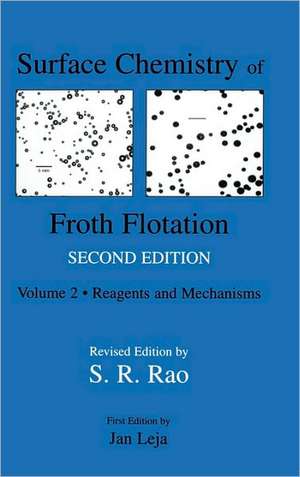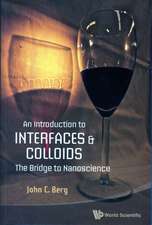Surface Chemistry of Froth Flotation: Volume 1: Fundamentals
Autor S. Ramachandra Raoen Limba Engleză Hardback – 31 dec 2003
| Toate formatele și edițiile | Preț | Express |
|---|---|---|
| Paperback (2) | 1004.57 lei 6-8 săpt. | |
| Springer Us – 16 feb 2013 | 1004.57 lei 6-8 săpt. | |
| Springer Us – 12 noi 2012 | 2113.92 lei 6-8 săpt. | |
| Hardback (1) | 1829.68 lei 3-5 săpt. | |
| Springer Us – 31 dec 2003 | 1829.68 lei 3-5 săpt. |
Preț: 1829.68 lei
Preț vechi: 2231.31 lei
-18% Nou
Puncte Express: 2745
Preț estimativ în valută:
350.14€ • 363.49$ • 291.97£
350.14€ • 363.49$ • 291.97£
Carte disponibilă
Livrare economică 01-15 martie
Preluare comenzi: 021 569.72.76
Specificații
ISBN-13: 9780306481802
ISBN-10: 0306481804
Pagini: 744
Ilustrații: XXXII, 744 p. In 2 volumes, not available separately.
Greutate: 0.82 kg
Ediția:2nd ed. 2004
Editura: Springer Us
Colecția Springer
Locul publicării:New York, NY, United States
ISBN-10: 0306481804
Pagini: 744
Ilustrații: XXXII, 744 p. In 2 volumes, not available separately.
Greutate: 0.82 kg
Ediția:2nd ed. 2004
Editura: Springer Us
Colecția Springer
Locul publicării:New York, NY, United States
Public țintă
ResearchCuprins
1. Introduction.- 2. Chemical Bonding and Structure of Solids.- 3. Aqueous Solutions, Slurries and Pulp.- 4. Physical Chemistry of Interfaces.- 5. Electrical Characteristics at Interfaces.- 6. Surface Forces in Flotation.- 7. Adsorption from Solutions.- 8. Hydrophobicity and Contact Angle.- 9. Flotation Surfactants.- 10. Collector Mechanism I. Thiol Collectors in Sulfide Minerals.- 11. Collector Mechanism II. Non-Thiol Collectors.- 12. Mechanism of the Action of Modifying Agents.- 13. Frothers and Frothing.- 14. Flotation Kinetics and Fine Particles Flotation.- References.- References.
Descriere
Descriere de la o altă ediție sau format:
th The technology of froth flotation, invented in the early 20 century was first used for the concentration of sulfide minerals. Since then it has been applied for the processing of many nonsulfide ores as weIl, including oxides, carbonates, silicates, soluble minerals like halite and sylvite and energy minerals like coal and bitumen. In recent years it has been used for several nonrnineral applications, such as waste water treatment, deinking of paper for recycling and resource recovery from industrial wastes he technology continues to grow with new applications reported every year. Flotation is based on chemical phenomena occurring at the interfaces, solid/water and air/water. Surface Chemistry principles have played a significant role in the development of flotation technology. Knowledge of aqueous solution chemistry and electrochemistry has added to our understanding of the reactions in flotation systems. Professor Jan Leja's book has weIl served researchers and students as they tried to understand the chemistry of flotation, and it is a significant contribution to the advancement of knowledge. However, since the book was first published, new research techniques and ever growing information have made an update necessary. The revised edition compiled by Dr. S. R. Rao has brought together fundamental aspects of the chemistry of flotation and how they apply to practical systems. It should serve all who are working in the area of flotation and interested in exploring new applications of flotation technology.
th The technology of froth flotation, invented in the early 20 century was first used for the concentration of sulfide minerals. Since then it has been applied for the processing of many nonsulfide ores as weIl, including oxides, carbonates, silicates, soluble minerals like halite and sylvite and energy minerals like coal and bitumen. In recent years it has been used for several nonrnineral applications, such as waste water treatment, deinking of paper for recycling and resource recovery from industrial wastes he technology continues to grow with new applications reported every year. Flotation is based on chemical phenomena occurring at the interfaces, solid/water and air/water. Surface Chemistry principles have played a significant role in the development of flotation technology. Knowledge of aqueous solution chemistry and electrochemistry has added to our understanding of the reactions in flotation systems. Professor Jan Leja's book has weIl served researchers and students as they tried to understand the chemistry of flotation, and it is a significant contribution to the advancement of knowledge. However, since the book was first published, new research techniques and ever growing information have made an update necessary. The revised edition compiled by Dr. S. R. Rao has brought together fundamental aspects of the chemistry of flotation and how they apply to practical systems. It should serve all who are working in the area of flotation and interested in exploring new applications of flotation technology.














